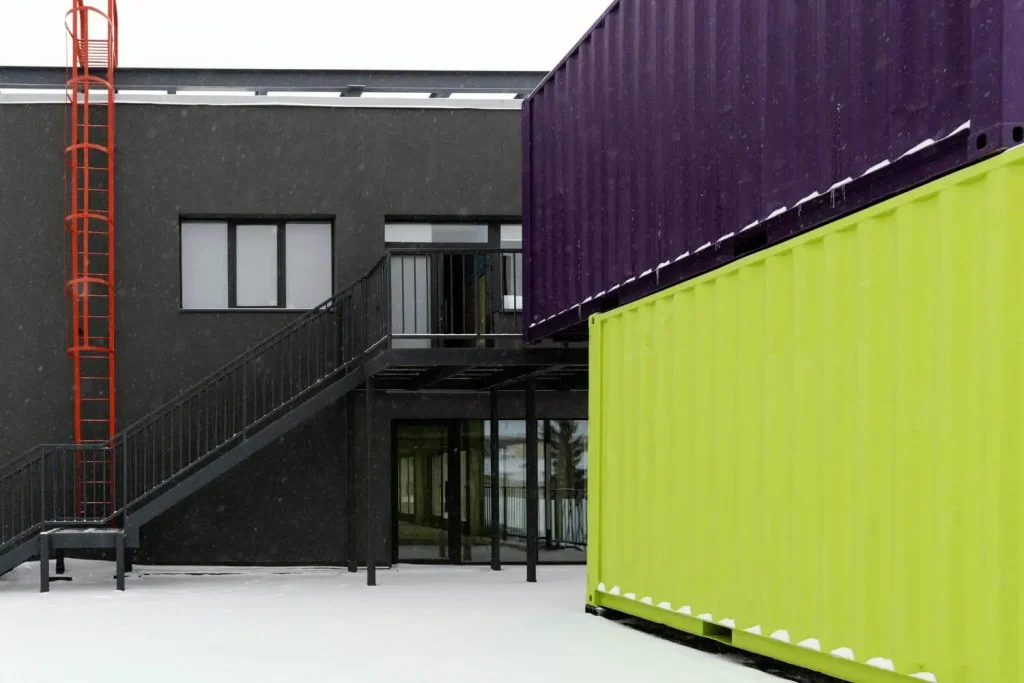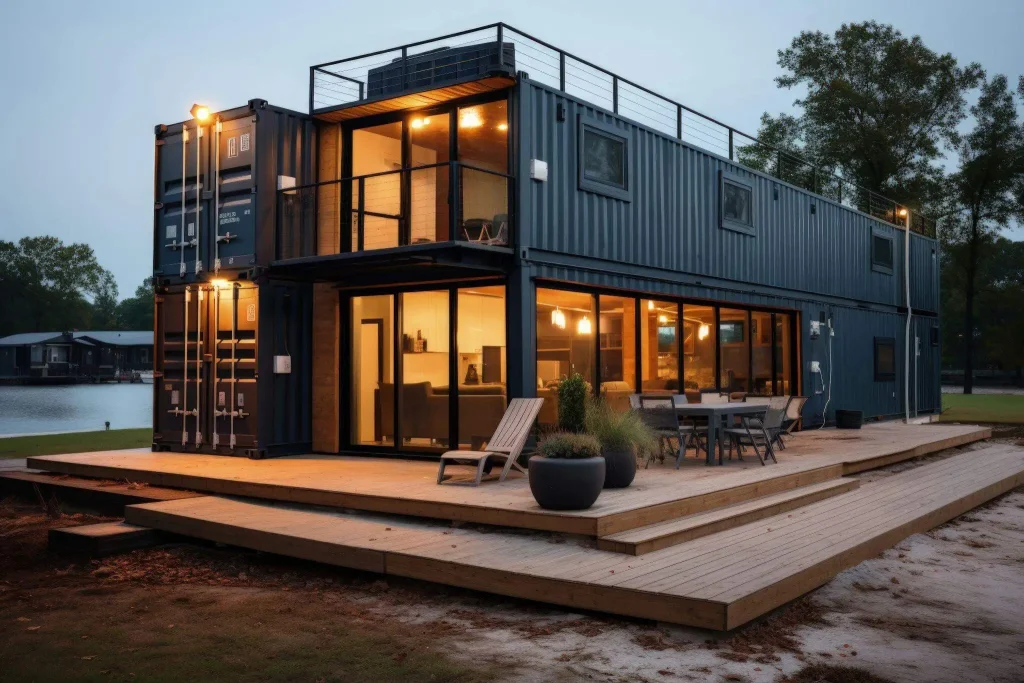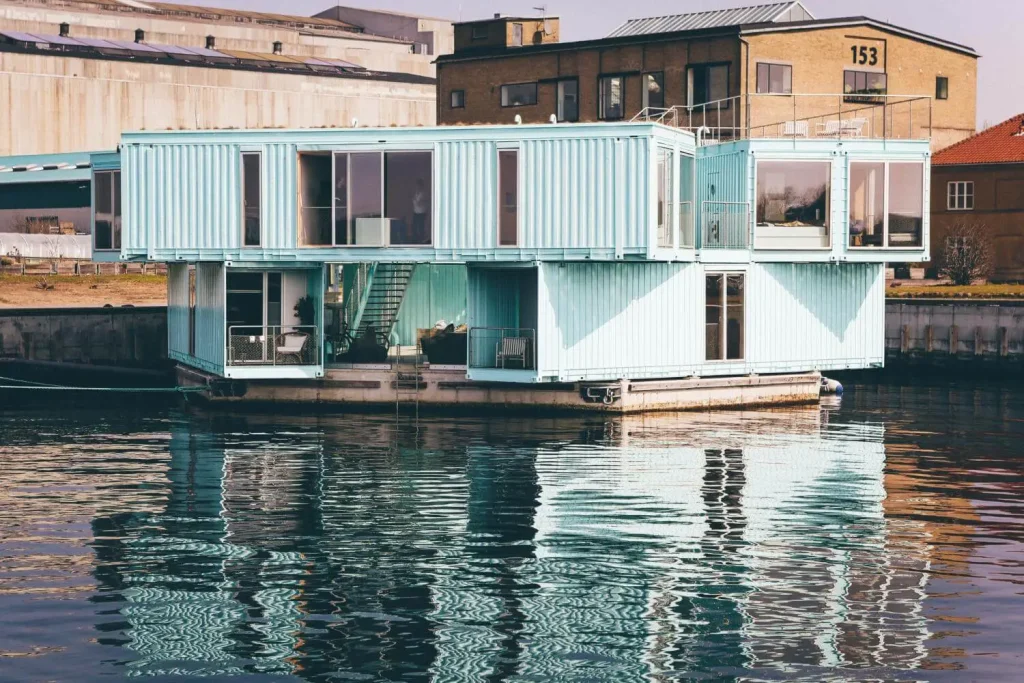What is a Container House?
A container house is a type of home built using one or more shipping containers that are traditionally used to transport goods across oceans. These containers are often made from high-strength steel, making them durable, weather-resistant, and structurally sound. Container houses come in various designs, from single-container tiny homes to multi-container complexes that create spacious, multi-room residences. Stacked designs allow homeowners to create multi-story dwellings, maximizing space and customization.
The Environmental Benefits of Container Houses
One of the strongest appeals of container houses is their positive impact on the environment. Each container used for housing helps reduce waste by recycling an item that would otherwise sit unused or be scrapped. By repurposing containers, the need for traditional building materials like cement and bricks is reduced, lowering the overall carbon footprint of the construction process. Additionally, container housing helps cut down on construction waste, as containers are pre-formed structures that only require modifications rather than complete builds from the ground up.
With environmental consciousness rising among consumers, container houses represent a sustainable choice that aligns with the principles of reduce, reuse, and recycle.

Cost-Effectiveness: A Key Attraction of Container Houses
Container houses are celebrated for their affordability, especially when compared to traditional housing costs. Several factors make container homes a cost-effective option:
- Reduced Material Costs: Since the structure is largely pre-built, material costs are much lower than building from scratch.
- Shorter Construction Time: Faster builds mean lower labor costs, as contractors spend fewer hours on site.
- Fewer Specialized Materials Needed: Container homes require fewer raw materials for walls and frameworks, saving on expenses without compromising on quality.
This makes container housing a practical solution, especially for those on a budget, such as young professionals, small families, and retirees.
Quick Construction Time
Compared to traditional homes, container houses can be constructed in a fraction of the time. A single-container home might be completed within a few weeks, while multi-container structures may take a few months at most. This rapid construction is possible because containers come pre-built, needing only modifications like cutting, insulation, and interior fittings to be transformed into livable spaces. For anyone looking to move into a new home quickly, container houses offer an unbeatable timeline.
One example is the popular “container village” model, which can create an entire neighborhood of homes within months, providing a quick solution to housing shortages or disaster relief.
Durability and Strength of Shipping Containers
Shipping containers are designed to withstand the harshest conditions, from high seas to extreme weather. Built from weather-resistant corten steel, these containers are highly durable, resistant to corrosion, and structurally sound. This strength translates directly into the benefits of container housing:
- Storm Resilience: With proper anchoring, container houses can withstand high winds, making them ideal for hurricane-prone regions.
- Long Lifespan: A well-maintained container home can last for several decades, offering a solid investment for the future.
Their sturdy construction also makes container houses viable options in regions prone to natural disasters, ensuring a durable, lasting home structure.
Flexibility and Customization of Design
Container houses offer immense flexibility in design and customization. The modular nature of shipping containers means they can be stacked, arranged, and combined in various configurations to suit the homeowner’s needs. Whether you want a simple single-container tiny home or a sprawling multi-room house with multiple levels, container homes make it possible.
- Interior Customization: Container homes can be outfitted with a wide range of interior finishes, from minimalist industrial to cozy, rustic aesthetics. Homeowners can install floors, paint walls, and add furnishings to reflect their personal style.
- Exterior Options: Containers can be painted, cladded with wood, or outfitted with decorative elements to blend in with the surrounding landscape. Options like rooftop gardens, decks, and outdoor patios enhance the appeal and utility of container homes.
Container houses essentially allow for a “design-your-own-home” experience, giving homeowners the creative freedom to tailor every aspect of their space.
Mobility and Relocation Ease
One unique advantage of container houses is their ability to be relocated. Many container homes are designed to be transportable, meaning that owners can take their home with them if they choose to move. This portability makes container housing especially attractive to people with a nomadic lifestyle or those working in industries that require frequent relocations, such as construction or consultancy.
- Transport-Ready Design: Shipping containers were made for transport, so container homes can often be relocated with minimal additional costs.
- Minimal Site Impact: Because of their modular nature, container homes can be set up on temporary foundations or piers, making them easy to relocate without extensive teardown or site disruption.
For those who crave flexibility and adventure, the mobility of container houses is a compelling feature that traditional homes can’t offer.

Minimalist Living and Space Optimization
Container houses naturally encourage minimalist living, as their compact space requires thoughtful design and efficient use of every square foot. This type of housing often aligns with those who seek a simpler, clutter-free lifestyle.
- Built-In Storage Solutions: With limited square footage, container homes can incorporate clever storage solutions like under-bed drawers, fold-out furniture, and wall-mounted cabinets.
- Open-Plan Layouts: Container homes are typically designed with open floor plans to maximize space, creating a spacious feel within a small footprint.
- Encouragement of Minimalism: The compact nature of container homes discourages unnecessary accumulation of possessions, making them an ideal choice for individuals interested in the minimalist lifestyle.
Living in a container house often helps people focus on essentials, reducing clutter and creating a serene, organized space.
Sustainable and Off-Grid Living Opportunities
Container homes provide an excellent foundation for eco-friendly and off-grid living. Their compact size makes it easy to integrate sustainable features, such as solar panels, rainwater harvesting systems, and energy-efficient appliances, for a reduced environmental impact.
- Solar Power Systems: Due to their often smaller energy needs, container homes are ideal for solar power setups. Solar panels can be installed on the roof, providing clean energy and enabling off-grid capabilities.
- Rainwater Collection: Many container homeowners install rainwater collection and filtration systems to reduce their dependence on municipal water sources.
- Composting Toilets and Greywater Systems: These sustainable waste management solutions reduce the environmental footprint of container houses, making them an excellent option for off-grid or remote living.
Container homes are a natural fit for eco-conscious individuals seeking a sustainable lifestyle, as they can easily be adapted to rely on renewable resources.
Increased Demand for Affordable Housing
With the global housing market facing affordability crises in many urban areas, container homes are emerging as a solution. Their cost-effectiveness, fast construction time, and adaptability make them attractive for developers and city planners seeking ways to address housing shortages. Cities worldwide are experimenting with container homes as affordable, transitional housing for low-income families, students, and even as emergency shelters.
- Urban Housing Projects: Several cities are adopting container housing developments to meet the needs of low-income populations and ease housing pressures.
- Student and Workforce Housing: Container homes offer affordable housing solutions for students and workers who require functional, compact spaces near urban centers.
- Emergency and Disaster Relief Housing: For communities affected by natural disasters, container homes provide a quick and cost-effective solution to rebuild homes and shelter displaced families.
As more cities face the challenge of providing affordable housing, container homes represent a viable, modern solution that meets both financial and social needs.

Eco-Friendly Construction Materials and Methods
The construction industry is one of the largest sources of global emissions, making eco-friendly building practices more important than ever. Container houses capitalize on recycled materials by reusing containers that would otherwise end up as scrap metal.
- Recycled Materials: Repurposing a container eliminates the need for new steel production, which reduces energy use and minimizes environmental impact.
- Reduced Need for Traditional Building Materials: With walls and structure already in place, container homes don’t rely heavily on traditional materials, reducing the demand for concrete, wood, and other resources.
- Waste Reduction: Container homes produce less construction waste, aligning with green building practices focused on minimizing environmental impact.
This sustainable approach to construction appeals to environmentally conscious consumers, reinforcing the eco-friendly allure of container homes.
Container Homes in Urban and Remote Areas
Container homes are incredibly versatile, making them suitable for a range of environments, from bustling urban settings to remote, off-the-grid locations. Urban planners are increasingly recognizing their potential to solve housing issues in densely populated cities, while rural enthusiasts find them appealing for their easy setup in isolated areas.
- Urban Appeal: In cities, container homes provide compact, modular housing solutions that can fit into small plots, rooftops, and infill sites.
- Remote Benefits: Container homes work well in rural areas where access to building materials may be limited. Their easy transportation and installation allow them to be set up in challenging locations with minimal infrastructure.
Whether nestled in a city block or placed in a secluded forest, container homes can meet the diverse needs of various homeowners.
Challenges and Limitations of Container Houses
While container homes offer many benefits, they come with some challenges. Understanding these can help potential owners make informed decisions.
- Insulation and Climate Control: Containers can heat up quickly in the summer and cool down rapidly in the winter, requiring effective insulation to maintain comfort.
- Zoning and Building Codes: In some areas, container homes may face zoning restrictions or stringent building codes, making it essential to check local regulations before building.
- Structural Modifications: Cutting and modifying a container can weaken its structure, so reinforcements may be necessary, especially for multi-level designs.
With thoughtful planning and expert assistance, many of these challenges can be managed, allowing homeowners to enjoy the numerous benefits container houses offer.
Looking for expandable container house manufacturers? DXH specializes in high-quality, durable expandable container homes. Offering a variety of sizes, including 20ft and 40ft options, DXH Container House provides versatile solutions for housing needs. These expandable homes are designed for easy setup and relocation, making them perfect for both residential and commercial applications. With a focus on quality and convenience, DXH ensures each container home meets rigorous standards, delivering comfortable, efficient living spaces. Explore DXH’s range of expandable container homes and discover flexible, sustainable housing options built to meet modern demands.
Conclusion: The Future of Container Housing
Container houses represent a modern, sustainable, and affordable housing option that appeals to an ever-growing audience. Their popularity continues to rise due to their cost-effectiveness, flexibility, and eco-friendly benefits, which address the changing needs and values of today’s homeowners. With innovation in design, customization, and sustainable features, container homes are not only here to stay but are likely to expand as a mainstream housing solution for people worldwide.

With a passion for matching clients with their dream homes, Mary’s experience and knowledge of the real estate market make her a trusted advisor. She’s your go-to expert for buying or selling properties in the heart of the city.





